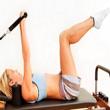Pilates
Pilates
Natural Standard Monograph, Copyright © 2013 (www.naturalstandard.com). Commercial distribution prohibited. This monograph is intended for informational purposes only, and should not be interpreted as specific medical advice. You should consult with a qualified healthcare provider before making decisions about therapies and/or health conditions.
Related Terms
Core strength training, exercise, matwork, Joseph Pilates, power pilates, resistance springs, Winsor Pilates.
Background
Pilates is a type of exercise designed to stretch, strengthen and balance the body. It is a full-body system of specific exercises that focus on the core postural muscles (abdomen and back) that help keep the body balanced. Pilates is based on the concepts of awareness, balance, breathing, mental focus, control, flowing movement, and precision. The principle of Pilates is to uniformly develop the body and mind. In particular, Pilates exercises teach awareness of neutral alignment of the spine and strengthening the deep postural muscles that support this alignment, which are important to help alleviate and prevent back pain.
In the early 1900s, Joseph Pilates was an apprentice of yoga, Zen and ancient Greek and Roman physical regimens, and developed the system of exercises typically used in Pilates today. Initially professional dancers, who appreciated improved strength, balance and flexibility, primarily used the Pilates exercise program.
Later, resistance springs were incorporated into rehabilitation programs for hospitalized patients. The springs were later transformed into unique Pilates equipment.
In the 1980s Pilates was rediscovered, and it is now a popular form of exercise. Pilates is often practiced in group mat classes (without equipment), or private or semi-private sessions with or without specially designed equipment.
Technique
Mat exercises primarily focus on strengthening the muscles of the trunk and hip and increasing the flexibility of both the spine and hips. While the scope of the mat program is limited compared to the exercises that use the equipment, there are many mat exercises that illustrate the Pilates principles. Individual lessons often use the unique Pilates equipment, which aids in creating resistance.
Reformer: The principal piece of equipment is called the reformer and consists of a sliding platform anchored at one end of its frame with springs. Pulling on ropes or pushing off from a stationary bar moves the platform. Exercises with this machine require the individual to maintain balance on a moving surface.
Cadillac: The cadillac consists of a padded platform with a cage-like frame above it. From this frame various bars or straps are attached by springs.
Wunda chair: The wunda chair consists of a small bench-like platform with a bar attached with springs. Exercises are done by pushing on the bar while either sitting or standing on the bench or standing or lying on the floor.
Theory/Evidence
Research shows that if practiced consistently, Pilates increases strength, length and flexibility of muscles, particularly of the abdomen and back muscles. Preliminary research suggests that Pilates may help treat obesity, reduce low back pain, and help with spine alignment.
Experts claim that it will take six to eight weeks to see changes in physical appearance.
Safety
For those interested in Pilates, especially those who do not regularly exercise, it is recommended to begin workouts slowly and build up activity gradually.
Use cautiously with heart disease, high blood pressure, asthma, dizziness or balance problems, bone or joint problems, diabetes or any new undiagnosed medical condition.
Author Information
This information has been edited and peer-reviewed by contributors to the Natural Standard Research Collaboration (www.naturalstandard.com).
Bibliography
Natural Standard developed the above evidence-based information based on a thorough systematic review of the available scientific articles. For comprehensive information about alternative and complementary therapies on the professional level, go to www.naturalstandard.com. Selected references are listed below.
AARP. www.aarp.org
Pilates Method Alliance. www.pilatesmethodalliance.org
Copyright © 2013 Natural Standard (www.naturalstandard.com)
The information in this monograph is intended for informational purposes only, and is meant to help users better understand health concerns. Information is based on review of scientific research data, historical practice patterns, and clinical experience. This information should not be interpreted as specific medical advice. Users should consult with a qualified healthcare provider for specific questions regarding therapies, diagnosis and/or health conditions, prior to making therapeutic decisions.
Updated:
March 22, 2017
